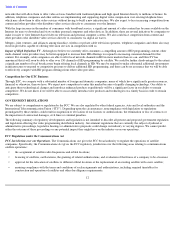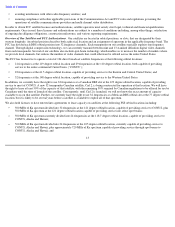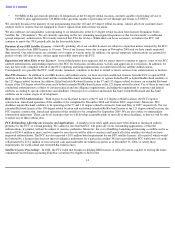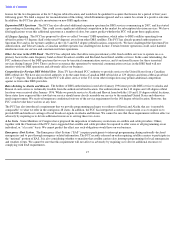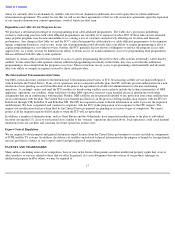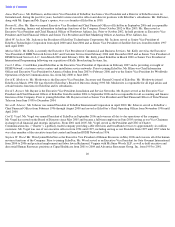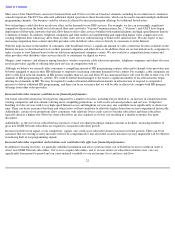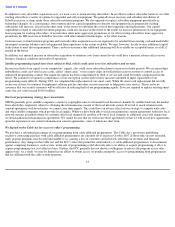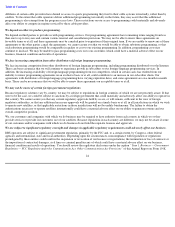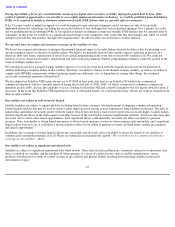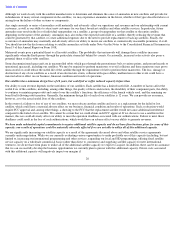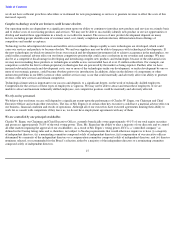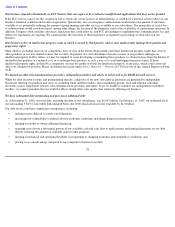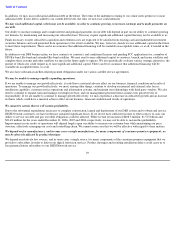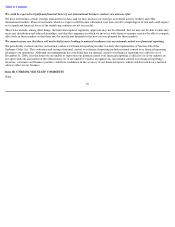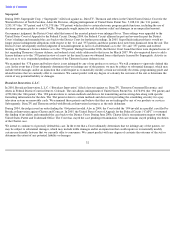Dish Network 2007 Annual Report Download - page 29
Download and view the complete annual report
Please find page 29 of the 2007 Dish Network annual report below. You can navigate through the pages in the report by either clicking on the pages listed below, or by using the keyword search tool below to find specific information within the annual report.
Table of Contents
Most areas of the United States can receive between three and 10 free over the air broadcast channels, including local content most consumers
consider important. The FCC has allocated additional digital spectrum to these broadcasters, which can be used to transmit multiple additional
programming channels. Our business could be adversely affected by increased program offerings by traditional broadcasters.
New technologies could also have an adverse effect on the demand for our DBS services. For example, we face an increasingly significant
competitive threat from the build-out of advanced fiber optic networks. Verizon Communications, Inc. (“Verizon”) and AT&T have begun
deployment of fiber-optic networks that will allow them to offer video services bundled with traditional phone and high speed Internet directly
to millions of homes. In addition, telephone companies and other entities are implementing and supporting digital video compression over
existing telephone lines which may allow them to offer video services without having to build a new infrastructure. We also expect to face
increasing competition from content and other providers who distribute video services directly to consumers over the Internet.
With the large increase in the number of consumers with broadband service, a significant amount of video content has become available on the
Internet for users to download and view on their personal computers and other devices. In addition, there are several initiatives by companies to
make it easier to view Internet-based video on television and personal computer screens. We also could face competition from content and
other providers who distribute video services directly to consumers via digital air waves.
Mergers, joint ventures, and alliances among franchise, wireless or private cable television operators, telephone companies and others also may
result in providers capable of offering television services in competition with us.
Although we believe we currently offer consumers a compelling amount of HD programming content, other multi-
channel video providers may
be better equipped to increase their HD offerings to respond to increasing consumer demand for this content. For example, cable companies are
able to offer local network channels in HD in more markets than we can, and DirecTV has announced that it will soon be able to offer over 150
channels of HD programming by satellite. We could be further disadvantaged to the extent a significant number of local broadcasters begin
offering local channels in HD. We may be required to make substantial additional investments in infrastructure to respond to competitive
pressure to deliver additional HD programming, and there can be no assurance that we will be able to effectively compete with HD program
offerings from other video providers.
Increased subscriber turnover could harm our financial performance.
Our future subscriber churn may be negatively impacted by a number of factors, including but not limited to, an increase in competition from
existing competitors and new entrants offering more compelling promotions, as well as new advanced products and services. Competitor
bundling of video services with 2-way high speed Internet access and telephone services may also contribute more significantly to churn over
time. There can be no assurance that these and other factors will not contribute to relatively higher churn than we have experienced historically.
Additionally, certain of our promotions allow consumers with relatively lower credit scores to become subscribers and these subscribers
typically churn at a higher rate. However, these subscribers are also acquired at a lower cost resulting in a smaller economic loss upon
disconnect.
Additionally, as the size of our subscriber base increases, even if our churn percentage remains constant or declines, increasing numbers of
gross new DISH Network subscribers are required to sustain net subscriber growth.
Increases in theft of our signal, or our competitors’ signals, also could cause subscriber churn to increase in future periods. There can be no
assurance that our existing security measures will not be compromised or that any future security measures we may implement will be effective
in reducing theft of our programming signals.
Increased subscriber acquisition and retention costs could adversely affect our financial performance.
In addition to leasing receivers, we generally subsidize installation and all or a portion of the cost of EchoStar receiver systems in order to
attract new DISH Network subscribers. Our costs to acquire subscribers, and to a lesser extent our subscriber retention costs, can vary
significantly from period to period and can cause material variability to our net income (loss) and free cash flow.
22


